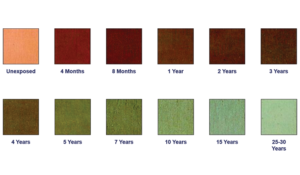Basics of copper
- Natural metal family of materials which develops patina naturally over time
- Has been used for centuries
- Ability to form complex shapes due to malleability
- Prestigious appearance
- Durable and corrosion resistant
- Long lasting metal requiring minimal maintenance
- Low thermal expansion values falls in between aluminum and steel
- May be soldered
Copper and sustainability
- Due to its value, copper roofing and wall cladding doesn’t end up in landfills, but is salvaged and recycled
- Copper is 100% recyclable
- Can be perpetually recycled without loss of performance or qualities
Copper facts
- 16 oz Copper > 24 ga> .022” thickness
- 20 oz Copper > 22 ga > .027” thickness
Patina finish – natural
- The natural weathering of copper to the characteristic bluegreen or gray-green patina is a direct consequence of the mild corrosive attack of airborne sulfur compounds.
- In industrial and seacoast atmospheres, the natural patina generally forms in five to seven years
- In rural atmospheres, it may not fully patina until 10 to 15 years, or longer
- In arid desert environments, patina formation may never occur and the copper surface may weather to a dark brown or bronze color
Pre-patinated finish – factory
- Copper mills have developed pre-patinated (aka preoxidized) copper sheet products due to requests from the architectural community
- The patina is a chemical conversion process whereby the top molecular surface of the copper sheet is enhanced and forced to produce a natural patina
- It is very important to have physical samples when choosing a color
- Some pre-patinated sheets have a variation in their color
Precautions
- Gloves should be worn when handling copper, as oils from fingerprints can be quite visible on that material
- Copper specific training for contractors is highly recommended
- Copper Development Association offers programs
- Refer to building panel transit, jobsite handling and storage procedures document on the ATAS website



